中英文文献翻译-燃料乙醇产业的发展机遇与挑战
- 格式:doc
- 大小:40.50 KB
- 文档页数:5
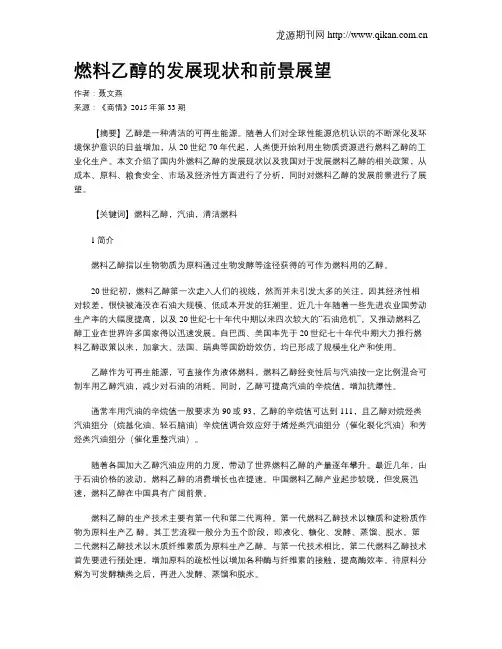
燃料乙醇的发展现状和前景展望作者:聂文燕来源:《商情》2015年第33期【摘要】乙醇是一种清洁的可再生能源。
随着人们对全球性能源危机认识的不断深化及环境保护意识的日益增加,从20世纪70年代起,人类便开始利用生物质资源进行燃料乙醇的工业化生产。
本文介绍了国内外燃料乙醇的发展现状以及我国对于发展燃料乙醇的相关政策,从成本、原料、粮食安全、市场及经济性方面进行了分析,同时对燃料乙醇的发展前景进行了展望。
【关键词】燃料乙醇,汽油,清洁燃料1简介燃料乙醇指以生物物质为原料通过生物发酵等途径获得的可作为燃料用的乙醇。
20世纪初,燃料乙醇第一次走入人们的视线,然而并未引发太多的关注,因其经济性相对较差,很快被淹没在石油大规模、低成本开发的狂潮里。
近几十年随着一些先进农业国劳动生产率的大幅度提高,以及20世纪七十年代中期以来四次较大的“石油危机”,又推动燃料乙醇工业在世界许多国家得以迅速发展。
自巴西、美国率先于20世纪七十年代中期大力推行燃料乙醇政策以来,加拿大、法国、瑞典等国纷纷效仿,均已形成了规模生化产和使用。
乙醇作为可再生能源,可直接作为液体燃料,燃料乙醇经变性后与汽油按一定比例混合可制车用乙醇汽油,减少对石油的消耗。
同时,乙醇可提高汽油的辛烷值,增加抗爆性。
通常车用汽油的辛烷值一般要求为90或93,乙醇的辛烷值可达到111,且乙醇对烷烃类汽油组分(烷基化油、轻石脑油)辛烷值调合效应好于烯烃类汽油组分(催化裂化汽油)和芳烃类汽油组分(催化重整汽油)。
随着各国加大乙醇汽油应用的力度,带动了世界燃料乙醇的产量逐年攀升。
最近几年,由于石油价格的波动,燃料乙醇的消费增长也在提速。
中国燃料乙醇产业起步较晚,但发展迅速,燃料乙醇在中国具有广阔前景。
燃料乙醇的生产技术主要有第一代和第二代两种。
第一代燃料乙醇技术以糖质和淀粉质作物为原料生产乙醇。
其工艺流程一般分为五个阶段,即液化、糖化、发酵、蒸馏、脱水。
第二代燃料乙醇技术以木质纤维素质为原料生产乙醇。
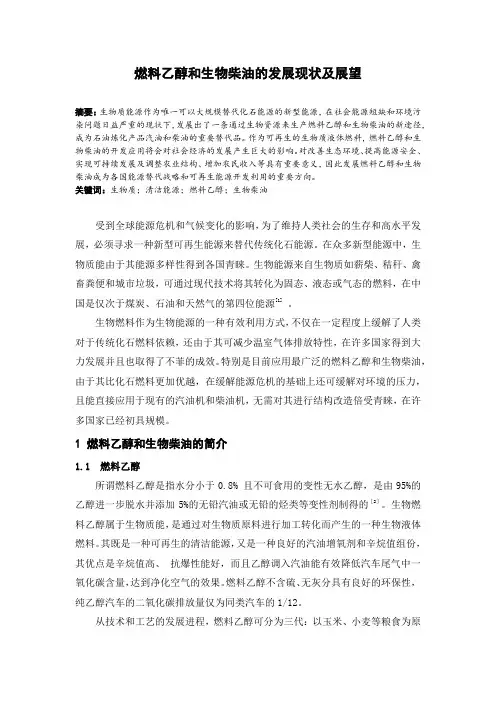
燃料乙醇和生物柴油的发展现状及展望摘要:生物质能源作为唯一可以大规模替代化石能源的新型能源,在社会能源短缺和环境污染问题日益严重的现状下,发展出了一条通过生物资源来生产燃料乙醇和生物柴油的新途径,成为石油炼化产品汽油和柴油的重要替代品。
作为可再生的生物质液体燃料,燃料乙醇和生物柴油的开发应用将会对社会经济的发展产生巨大的影响。
对改善生态环境、提高能源安全、实现可持续发展及调整农业结构、增加农民收入等具有重要意义,因此发展燃料乙醇和生物柴油成为各国能源替代战略和可再生能源开发利用的重要方向。
关键词:生物质;清洁能源;燃料乙醇;生物柴油受到全球能源危机和气候变化的影响,为了维持人类社会的生存和高水平发展,必须寻求一种新型可再生能源来替代传统化石能源。
在众多新型能源中,生物质能由于其能源多样性得到各国青睐。
生物能源来自生物质如薪柴、秸秆、禽畜粪便和城市垃圾,可通过现代技术将其转化为固态、液态或气态的燃料,在中国是仅次于煤炭、石油和天然气的第四位能源[1]。
生物燃料作为生物能源的一种有效利用方式,不仅在一定程度上缓解了人类对于传统化石燃料依赖,还由于其可减少温室气体排放特性,在许多国家得到大力发展并且也取得了不菲的成效。
特别是目前应用最广泛的燃料乙醇和生物柴油,由于其比化石燃料更加优越,在缓解能源危机的基础上还可缓解对环境的压力,且能直接应用于现有的汽油机和柴油机,无需对其进行结构改造倍受青睐,在许多国家已经初具规模。
1 燃料乙醇和生物柴油的简介1.1 燃料乙醇所谓燃料乙醇是指水分小于0.8% 且不可食用的变性无水乙醇,是由95%的乙醇进一步脱水并添加5%的无铅汽油或无铅的烃类等变性剂制得的[2]。
生物燃料乙醇属于生物质能,是通过对生物质原料进行加工转化而产生的一种生物液体燃料。
其既是一种可再生的清洁能源,又是一种良好的汽油增氧剂和辛烷值组份,其优点是辛烷值高、抗爆性能好,而且乙醇调入汽油能有效降低汽车尾气中一氧化碳含量,达到净化空气的效果。
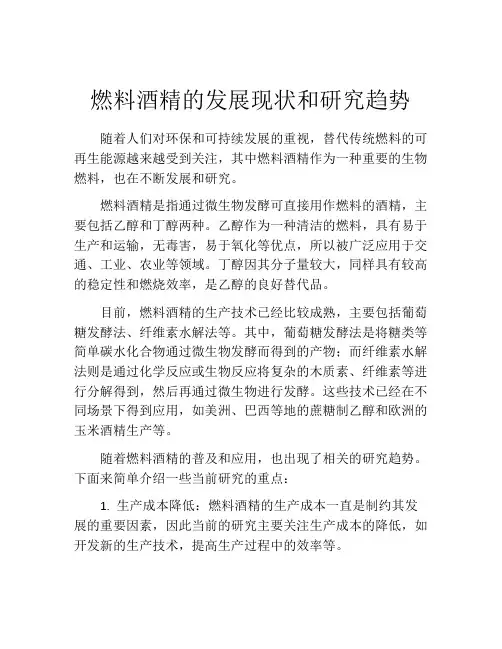
燃料酒精的发展现状和研究趋势随着人们对环保和可持续发展的重视,替代传统燃料的可再生能源越来越受到关注,其中燃料酒精作为一种重要的生物燃料,也在不断发展和研究。
燃料酒精是指通过微生物发酵可直接用作燃料的酒精,主要包括乙醇和丁醇两种。
乙醇作为一种清洁的燃料,具有易于生产和运输,无毒害,易于氧化等优点,所以被广泛应用于交通、工业、农业等领域。
丁醇因其分子量较大,同样具有较高的稳定性和燃烧效率,是乙醇的良好替代品。
目前,燃料酒精的生产技术已经比较成熟,主要包括葡萄糖发酵法、纤维素水解法等。
其中,葡萄糖发酵法是将糖类等简单碳水化合物通过微生物发酵而得到的产物;而纤维素水解法则是通过化学反应或生物反应将复杂的木质素、纤维素等进行分解得到,然后再通过微生物进行发酵。
这些技术已经在不同场景下得到应用,如美洲、巴西等地的蔗糖制乙醇和欧洲的玉米酒精生产等。
随着燃料酒精的普及和应用,也出现了相关的研究趋势。
下面来简单介绍一些当前研究的重点:1. 生产成本降低:燃料酒精的生产成本一直是制约其发展的重要因素,因此当前的研究主要关注生产成本的降低,如开发新的生产技术,提高生产过程中的效率等。
2. 提高燃料酒精的质量:燃料酒精的品质直接影响到其使用效果和污染物的排放情况,因此当前的研究主要关注提高燃料酒精的纯度和稳定性,降低其对环境的影响。
3. 燃料酒精与新能源的互补:随着国家大力推进新能源的发展,燃料酒精作为一种重要的生物燃料也需要和新能源相互补充,提高能源的利用率,如研究燃料酒精和太阳能、风能等新能源的联合应用等。
总的来说,燃料酒精是具有广泛前景和市场需求的生物燃料,随着相关生产和科研技术的不断发展,相信未来它将会在替代传统燃料和促进环境保护方面发挥更加重要的作用。

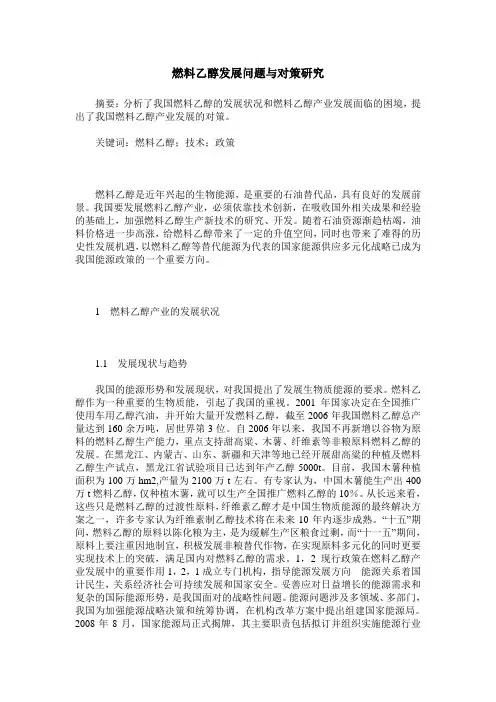
燃料乙醇发展问题与对策研究摘要:分析了我国燃料乙醇的发展状况和燃料乙醇产业发展面临的困境,提出了我国燃料乙醇产业发展的对策。
关键词:燃料乙醇;技术;政策燃料乙醇是近年兴起的生物能源,是重要的石油替代品,具有良好的发展前景。
我国要发展燃料乙醇产业,必须依靠技术创新,在吸收国外相关成果和经验的基础上,加强燃料乙醇生产新技术的研究、开发。
随着石油资源渐趋枯竭,油料价格进一步高涨,给燃料乙醇带来了一定的升值空间,同时也带来了难得的历史性发展机遇,以燃料乙醇等替代能源为代表的国家能源供应多元化战略已成为我国能源政策的一个重要方向。
1燃料乙醇产业的发展状况1.1发展现状与趋势我国的能源形势和发展现状,对我国提出了发展生物质能源的要求。
燃料乙醇作为一种重要的生物质能,引起了我国的重视。
2001年国家决定在全国推广使用车用乙醇汽油,并开始大量开发燃料乙醇,截至2006年我国燃料乙醇总产量达到160余万吨,居世界第3位。
自2006年以来,我国不再新增以谷物为原料的燃料乙醇生产能力,重点支持甜高粱、木薯、纤维素等非粮原料燃料乙醇的发展。
在黑龙江、内蒙古、山东、新疆和天津等地已经开展甜高粱的种植及燃料乙醇生产试点,黑龙江省试验项目已达到年产乙醇5000t。
目前,我国木薯种植面积为100万hm2,产量为2100万t左右。
有专家认为,中国木薯能生产出400万t燃料乙醇,仅种植木薯,就可以生产全国推广燃料乙醇的10%。
从长远来看,这些只是燃料乙醇的过渡性原料,纤维素乙醇才是中国生物质能源的最终解决方案之一,许多专家认为纤维素制乙醇技术将在未来10年内逐步成熟。
“十五”期间,燃料乙醇的原料以陈化粮为主,是为缓解生产区粮食过剩,而“十一五”期间,原料上要注重因地制宜,积极发展非粮替代作物,在实现原料多元化的同时更要实现技术上的突破,满足国内对燃料乙醇的需求。
1,2现行政策在燃料乙醇产业发展中的重要作用1,2,1成立专门机构,指导能源发展方向能源关系着国计民生,关系经济社会可持续发展和国家安全。
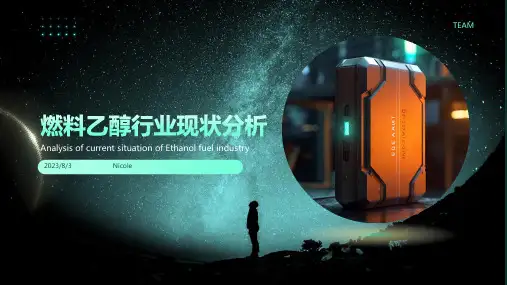

燃料乙醇的研究进展燃料乙醇的研究进展摘要:介绍燃料乙醇在国内外的发展现状及发展前景,以及燃料乙醇的生产技术、产业发展及应用概况。
关键词:燃料乙醇,可再生能源,发酵法Key words:Fuel ethanol,Renewable Energy,Fermentation前言:燃料乙醇的概念:燃料乙醇也称生物燃料、燃料酒精、汽油醇、乙醇汽油等。
将乙醇进一步脱水再加上适量的变性剂后形成变性燃料乙醇。
燃料乙醇产生于20世纪20年代,随着石油的大规模、低成本开发,酒精因其经济性较差而被淘汰。
石油是不可再生的能源,石油枯竭迟早要到来,为了减轻对石油的依赖,人们都在寻找可再生能源。
同时,农业的快速发展,造成粮食大量过剩,这一切,都使燃料乙醇产业的重新崛起和迅速发展成为必然。
近年来汽油醇的生产又成为炼油工业的一个方向。
所谓车用乙醇汽油,就是把变性燃料乙醇和汽油以一定比例混配,形成一种新型混合燃料。
我国初步确定从乙醇的体积分数为10%起步推广使用车用汽油醇,这样现有车辆不需任何改装。
其油耗、动力基本不受影响,汽车尾气的污染可大幅度降低,又不消耗过多的粮食。
然而,燃料乙醇工业在如火如荼发展的同时,也要消耗大量农作物,这是否大幅度抬高了全球物价;大面积的占用热带雨林种植经济性作物是否会在环境保护上得不偿失,这些问题都使燃料乙醇成为关注的热点。
国内外发展状况:美国已是第一大燃料乙醇生产国,2007年8月美国乙醇产量达到277. 0亿L。
美国燃料乙醇生产主要依靠玉米。
通过转基因技术并扩大种植面积,美国玉米产量近年增长迅速,目前有30%的玉米用于燃料乙醇的生产。
巴西是世界上唯一不供应车用纯汽油的国家,2006年其酒精产量达到170亿L,是第二大燃料乙醇生产国。
在巴西的加油站里含水酒精的售价已经降为汽油的60% ~70%。
在全球率先实现了酒精相对于汽油的经济竞争力。
世界4大酒精生产国除巴西和美国之外,就是我国和俄罗斯。
我国主要利用玉米生产燃料乙醇,也有利用薯类和甘蔗生产的报道。
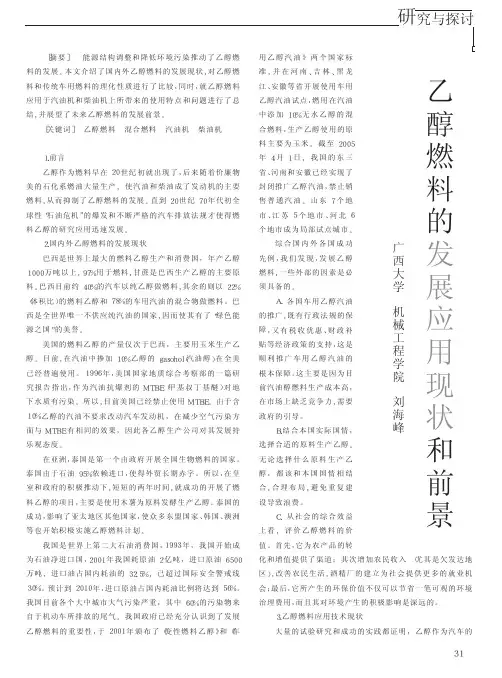
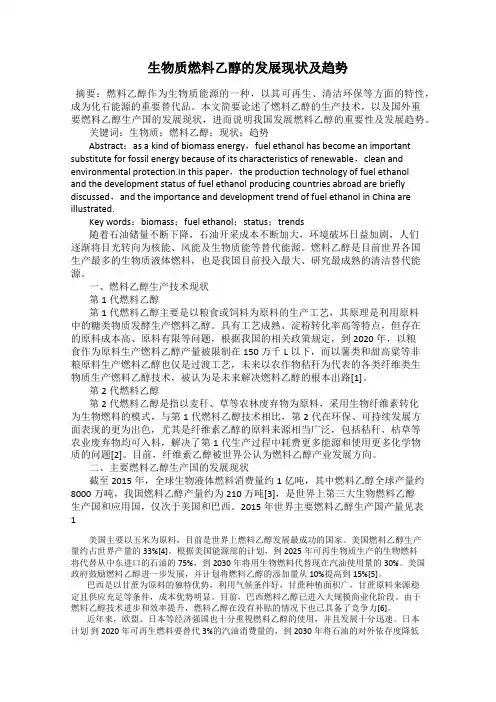
生物质燃料乙醇的发展现状及趋势摘要:燃料乙醇作为生物质能源的一种,以其可再生、清洁环保等方面的特性,成为化石能源的重要替代品。
本文简要论述了燃料乙醇的生产技术,以及国外重要燃料乙醇生产国的发展现状,进而说明我国发展燃料乙醇的重要性及发展趋势。
关键词:生物质;燃料乙醇;现状;趋势Abstract:as a kind of biomass energy,fuel ethanol has become an important substitute for fossil energy because of its characteristics of renewable,clean and environmental protection.In this paper,the production technology of fuel ethanoland the development status of fuel ethanol producing countries abroad are briefly discussed,and the importance and development trend of fuel ethanol in China are illustrated.Key words:biomass;fuel ethanol;status;trends随着石油储量不断下降,石油开采成本不断加大,环境破坏日益加剧,人们逐渐将目光转向为核能、风能及生物质能等替代能源。
燃料乙醇是目前世界各国生产最多的生物质液体燃料,也是我国目前投入最大、研究最成熟的清洁替代能源。
一、燃料乙醇生产技术现状第1代燃料乙醇第1代燃料乙醇主要是以粮食或饲料为原料的生产工艺,其原理是利用原料中的糖类物质发酵生产燃料乙醇。
具有工艺成熟、淀粉转化率高等特点,但存在的原料成本高、原料有限等问题,根据我国的相关政策规定,到2020年,以粮食作为原料生产燃料乙醇产量被限制在150万千L以下,而以薯类和甜高粱等非粮原料生产燃料乙醇也仅是过渡工艺,未来以农作物秸秆为代表的各类纤维类生物质生产燃料乙醇技术,被认为是未来解决燃料乙醇的根本出路[1]。

燃料酒精的发展现状和研究趋势燃料酒精作为一种可再生能源,具有许多优点,如低碳排放、可降低对环境的影响、能够减少对传统化石燃料的依赖等。
因此,燃料酒精的研究和发展一直备受关注。
本文将讨论燃料酒精的发展现状和研究趋势。
首先,从发展现状来看,燃料酒精主要包括乙醇和甲醇两种类型。
乙醇燃料是最常见的燃料酒精,主要由粮食作物(如玉米、小麦)、纤维作物(如甘蔗、甜菜)和木质纤维素等生物质中的糖分发酵得到。
与传统化石燃料相比,乙醇燃料具有更高的氧含量,燃烧效率更高,能够有效减少有害物质排放。
甲醇燃料则主要由甲醇制备而成,甲醇可以通过天然气重整、合成气转化、生物质气化等方法得到。
甲醇燃料具有较高的能量密度,能够作为燃料电池的燃料或直接用于发动机燃烧。
在发展方面,全球范围内对燃料酒精的需求不断增长。
尤其是在环保和能源安全意识的提高下,燃料酒精已成为替代传统燃料的重要选择。
许多国家和地区已经出台相关政策,支持燃料酒精的研发和应用。
例如,美国实施了生物质税收奖励制度,鼓励农民生产乙醇原料;巴西则推动了大规模生产乙醇燃料的发展,取得了显著的成果。
此外,欧盟、中国、印度等国家也纷纷加大对燃料酒精产业的扶持力度。
在研究方面,燃料酒精的研究重点主要集中在以下几个方面。
首先是生物质转化技术的改进。
生物质转化是燃料酒精生产的关键环节,提高生物质转化的效率和经济性是当前的研究热点。
目前,利用遗传改良和微生物代谢工程等技术手段,已经成功提高了乙醇和甲醇的产率和纯度。
其次是原料的多样化利用。
除了传统的粮食作物和纤维作物,研究人员还在探索利用废弃物和非食用植物等可再生资源,扩大燃料酒精原料的供给范围。
第三是生产工艺的革新。
传统的生产工艺往往存在能耗高、成本昂贵等问题,因此研究人员正在寻找更加高效、环保的生产工艺,包括发展新型催化剂和优化反应条件等。
此外,燃料酒精的应用也日趋广泛。
除了传统的交通运输领域,燃料酒精还在航空航天、热能和电力等领域得到应用。
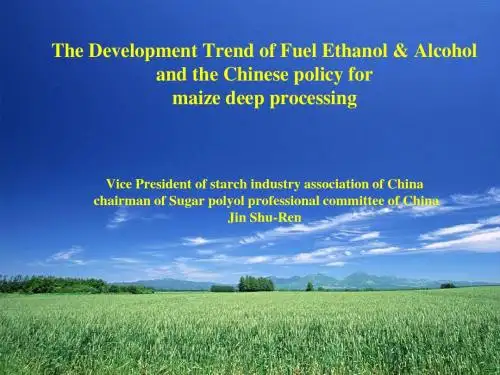
中国燃料乙醇发展面临的困难及建议刘钺;杜风光【期刊名称】《酿酒科技》【年(卷),期】2018(000)003【摘要】The scale of fuel ethanol industry in China ranks No.3 in the world, its related technologies have reached the latest ad-vanced level, and its popularization and utilization are mature, safe, and reliable. However, there are still lots of difficulties in wide utilization of fuel ethanol in China such as the planning goal,the development path,fiscal policies and legal system guarantee,etc.In this paper,the current development situations of fuel ethanol in China and the existed difficulties were introduced,and the advice to popularize the use of fuel ethanol for vehicles nationwide was put forward.%中国燃料乙醇产业规模已居世界第三位,相关技术基本达到世界先进水平,推广使用方面也成熟可靠、安全可行.但是目前在全国更大范围推广应用还面临规划目标、发展路径、财税政策、法律制度保证等方面的障碍.分析了中国燃料乙醇发展的现状和进一步扩大应用存在的障碍,并提出了全国范围内推广使用车用乙醇汽油的建议,希望对中国燃料乙醇的发展有所借鉴.【总页数】7页(P129-135)【作者】刘钺;杜风光【作者单位】河南天冠企业集团有限公司,车用生物燃料技术国家重点实验室,河南南阳473000;河南天冠企业集团有限公司,车用生物燃料技术国家重点实验室,河南南阳473000【正文语种】中文【中图分类】TK6;TS262.2【相关文献】1.燃料乙醇发展概述和柿子燃料乙醇的发展建议 [J], 李小华;杨万洪;刘希文;朱宗祥2.中国非粮燃料乙醇产业发展分析与政策建议 [J], 陈茜;黄晨倩;陈莺3.中国磷化工面临的困难、机遇和发展建议 [J], 寇丽华;陈嘉甫4.中国燃料乙醇的应用现状及推广建议 [J], 秦汉俊;徐建东;开金龙;束震5.中国生物燃料乙醇产业发展现状、存在问题及政策建议 [J], 冯文生;李晓;康新凯;杜风光因版权原因,仅展示原文概要,查看原文内容请购买。
China’s Biomass EnergyChina leads the world in its energy reservation and is the second largest energy producer and consumer in the world. It is estimated that China has 4000 billion tons of potential primary energy reservation. However, per capita energy resource quantity and consuming quantity is far smaller than the world average level. The main characteristics of China’s energy exploration and utilization are as follows.1. Coal is the primary energy; exploration and utilization of renewable resources is supplementary. China’s explored reserves of coal resource accounts for over 90% of the primary energy total, such as coal, oil, natural gas, water energy and nuclear energy. Coal is dominant id China’s energy production and consumption.on.2. Energy consumption volume is increasing while energy utilization efficiency is comparatively low. As the economic scale expands, China’s energy consumption is on the constant increase. Under the influences of capital, technology, energy price, etc, China’s energy utilization efficiency is far lower than that of the developed countries. Energy comprehensive utilization efficiency is 32% and the overall energy systematic efficiency 9.3%. These numbers are only half of the developed country level.3. With the sustained increase of energy consumption, the coal-dominant energy structure has caused urban air pollution while with the excessive consumption of bio-mass energy giving rise to ecological destruction, the pressure on ecological environment is more and more severe. According to the World Bank, the economic loss caused by air and water pollution in China, approximately accounts for 3%--8% of GNP.4. The energy structure is getting more and more pluralized. By the middle of the 1990’s, energy self-sufficiency rate was 98%, while at present China is the second largest crude oil importer only after USA.The rapid development of China’s economy is based on the sufficient supply of energy, however, the higher-than-normal oil price on the international market together wit h China’s ever-increasing energy demand will be a serious subject faced withChina’s development road.More than 3200 places of terrestrial heat have been discovered in China, 225 of them could be used for power generation. It is estimated that the exploitable reserve of terrestrial heat in China is equal to the power of 462.65 billion tons of standard coal. In recent years, the use of terrestrial heat in our country has increased by 7%. We have usedChina will adopt the sustainable energy development str ategy of an “energy saving prioritized, plural structured, and environment friendly” nature in the coming 20 years. We will adopt the international energy strategy and strive to quadruple GDP with double energy consumption with the help of mechanism innovation and technological advancement. The following specific goals are expected to reach under the sustained energy development strategy: energy consumption of per unit GNP will be reduced by 20% on the level of the end of the 10th five-year plan; primary energy demand will be less than 2.5 billion tons of standard coal by 2020, saving 0.8 billion tons; coal consumption ratio is controlled under 60%, renewable energy utilization reaches 525 million standard coal (power generation by renewable energy stands at 100 million kilowatt); oil importing reliance is controlled under around 60%; the reduction rate of main pollutants is 45%--60%.The Development of New Energy in ChinaNew energy and renewable energy only started to develop in China. As pointed out in the Annual Report of China’s New Energy Industry released in January, 2007, China will largely increase the rate of new energy such as wind power, solar power, and biomass power in the overall energy consumption. The report says, our first step is; the new energy installed capacity will be 120 million kw by 2020, that is 12% of China’s total installed power capacity. We will have a boost of power generation by using wind, bio-energy and solar energy. The second step is; the percentage of new energy consumption will increased dramatically comparing to other kind of energies. By 2050, the new energy will account for 30%--40% of the total energy demand of China. Now l would like to give you a brief introduction on wind power, biomass energy, solar energy and terrestrial energy in China.Wind PowerThere are abundant wind power within our huge territory and along our long coastline. According to the survey of China meteorological Academy, based on the results of 900 weather stations, there is 253 million kw of wind power reserve 10 m below our earth. There is a great potential of wind power in the coastal area of eastern China 2---15 meters below sea level. Therefor ,we have a promising future in wind power generation there.Compiled by China Energy Comprehensive Use Association and European Wind Power Society, in a Report named Wind Force 12 in China, it is expected that China will have 40 million kw of wind power capacity in 2020, if is could develop fully. Then, the wind power will go beyond nuclear power and become the third largest power source in China. If that is true, China’s annual wind power generation would go up to 80 billion kwh, it could be enough for 80 million people. Meantime, it would reduce 48 million tons of CO2 emission.The report also says that China will need over 25 thousand of large wind generators by the year 2020, wind power sale will increase to morethan 300 billion yuan, that will create at least 150 thousand of job opportunities. It indicates that in the past 5 years, the cost of wind power will reduce by 20%, its technology cost is one of the lowest which can be decreased among the renewable energies.Biomass energyAccording to the Outline for Mid-- long Term Development of Renewable Energy in China, the goal of renewable energy development in the next 15 years is; by 2020, the renewable energy will occupy 16% in the energy structure of China. Among them, the production of ethanol is going up to 10 million tons; bio-diesel fuel 2 million tons; and the major part of the biomass energy development target are bio-energy power generation, Firedamp projects biomass liquid fuel and Biomass solid fuel. The biomass project in China has made great progress now, but it is still in an initial stages.According to the Supporting Policy of Bio-energy and Bio-chemistrydevelopment jointly promulgated by several ministries, China will give favorable treatments to support biomass energy development in the following aspects: setting up risk fund system, providing flexible loss subsidy; subsidies for raw material bases and demonstration projects; tax reduction is included. We can predict that the biomass energy in China will be developed rapidly in years to come.Terrestrial Energy12604.6 GWH of terrestrial heat till 2005 with an installed capacity of 3687 MWT, which rank number 1 and number 3 in the world respectively.We use the high heat to generate power and low middle heat to daily purposes. three thermo-power plants have been build in Tibet now, the total installed capacity in China is 29 mw. Terrestrial heat Floors have seen both economical and environmental benefit in the northern part of China as well as in big or medium cities such as: Beijing, Tianjin, Xi’an and Anshan. It is growing fast in agricultural areas like green house (terrestrial),breed aquatics, irrigation, in health care, recreation and tourism ,too China tops the world in utilization of terrestrial heat, but it is only 0.5% of our total energy. Terrestrial power is only 0.35% of the world total generation. We still have a long way to go in developing and utilizing the terrestrial heat.Ocean EnergyExperts have pointed out, while we are exploring petroleum, natural gas, coal and petrification energy, China ought to focus on the future, exploring the promising ocean energy. The clean, renewable ocean energy is the key source of solving the global energy problem, exploiting of ocean energy has been aroused much attention in USA, UK and Australia, some of the experiments have entered a phase of trial operation and evaluation. However, China, Japan and other eastern Asian counties have not realized the true meaning of ocean energy exploration.China’s Energy StrategyIn order to achieve the goal of building a well-off society and face the severe challenge of the long-term energy development, it is of overriding significance for China to adopt the right energy development strategy. Drawing upon the successful experiences of the developed countries and also proceeding from its nationalcondition, China will establish a long and middle term sustainable energy strategy that is in accordance with increasing energy efficiency and protecting the environment.中国的生物质能源中国的能源蕴藏量位居世界前列,同时也是世界第二大能源生产国与消费国。
附录AFuel ethanol industry opportunities and challengesAt present, the fuel ethanol industry have great opportunities for development, but it also faces many challenges. Selection of fuel ethanol gasoline, a number of factors should be considered: vehicle and fuel prices, vehicle performance and ease of use, and emissions regulations, convenient refueling, maintenance costs, and maintenance convenience. The use of fuel ethanol and the cost effectiveness of its significant impact on the promotion of the use. According to China's specific circumstances, in the promotion of fuel ethanol and use the following key issues need to be resolved.(1)Fuel ethanol production costs of raw materials and fuel prices, the current gas and electricity prices low, methanol, ethanol is higher than the price of petrol and diesel. Only the price of fuel ethanol at less than the retail price of gasoline, only the economic viability.China's development of the corresponding financial subsidies or tax relief policies and environmental regulations in order to support and encourage the fuel ethanol and promote the use of ethanol gasoline. However, fuel ethanol production enterprises to continuously raise the level of production and comprehensive utilization of by-product level, develop the use of rich biological resources of raw materials and lower production costs, and ensure the health of fuel ethanol, the sustained development of enterprises.(2)Water storage and transportation of ethanol gasoline ethanol fuel stratified water to the use of low-cost pipeline. Foreign transportation of fuel ethanol, commonly used by automobiles, trains, ships and other means higher costs and also pay attention to gasoline storage and transportation of ethanol in water.(3)The cost of automotive technology and the use of foreign experience has shown that the fuel ethanol and flexible fuel vehicle prices high than the traditional automobile. Clean fuel vehicles used in the initial price and technical programs. According to the information, the use of ethanol gasoline, the fuel consumption of motor vehicles has increased, the performance of the engine power dropped to varying degrees; At the same time, ethanol, gasoline for vehicle fuel tank, carburetor and other parts of the non-ferrous metals, rubber materials have varying degrees Corrosion, automotive use of ethanol in gasoline before the need for adaptation, an increase of the cost. Due to the complexity of our models, the factory during the span, and resulting from the use of ethanol gasoline on the more prominent issues. Ethanol gasoline automobile engine wear and tear caused by corrosion, will shorten the life of car. Only increase the gasoline additive ethanol in order tosolve the problem. This requires the use of low-cost production and the use of the safety of gasoline or ethanol diesel fuel additive ethanol.(4)Ethanol gasoline vehicle emissions ethanol gasoline aldol use brought about by the increase in emissions, it must attract attention and give an effective solution.(5)Infrastructure supporting the commercialization of fuel ethanol applications, must have the appropriate infrastructure, that is, the fuel supply should be supporting factories, storage and transport facilities, the retail gas stations all over the country, parts supply and maintenance of networks. Infrastructure investment required in the various clean alternative fuel, the use of fuel ethanol is relatively low.(6)The development of diesel-ethanol to promote ethanol in gasoline, while diesel should also attach importance to the development of ethanol. Diesel consumption in China is big country, in 1999 consumption of diesel 61.2 million tons. At present, the production of domestic oil refining industry in the fuel, diesel and gasoline production ratio of consumption is lower than the market ratio between the number of diesel and petrol, the promotion of ethanol petrol, diesel supply shortage of resources have become an obvious contradiction.With the gradual depletion of fossil resources, the further rise in oil prices, which fuel ethanol to bring a certain amount of development and historical opportunity. Diversification of the national energy supply is an important national energy strategy, in the world's future energy mix, renewable bio-energy will be one of the main body of energy, the world's increasing emphasis on fuel ethanol development and application.According to the State "Fuel Ethanol and Ethanol" 15 "Development Plan", China's fuel ethanol industry is positioned to promote the industrialization of agriculture, improvement of the dual structure of the national economy, environmental protection and promotion of renewable energy use, and gradually as the goal to build a new, advanced technology, comprehensive utilization of high level of international influence and the industry. At the national "Eleventh Five-Year Plan" that clearly need to accelerate the development of wind energy, solar, biomass and other renewable energy sources.Fuel ethanol production technology development prospects, the performance in the following aspects.(1)With the prospect of fiber raw materials key technology breakthrough in ethanol and the success of the industrialized operation of the 21st century will be the greater use of grain and other agricultural products other than biomass to produce fuel ethanol, the use of land not suitable for grain and forest resources, planting appropriate energy plants.(2)The prospects of production technology to lower raw material costs as a result of technological progress and production, fuel ethanol at progressively lower prices.(3)The prospects for the development of engine technology and flexible fuel vehicles (FFV)is the application of fuel ethanol in one direction. The United States, Brazil and other countries have successfully developed the use of either gasoline or pure ethanol and pure than any match between the two mixed-fuel vehicles flexible fuel (FFV), is currently used in Brazil for more than a FFV vehicle 2000000.In short, our country promote the use of ethanol gasoline has been out of people "Tenth Five-Year" plan for national economic development has been significant progress has been made. According to foreign experience, China's population and a large proportion of the agricultural economy, rich in coal resources, the development of energy resources, distribution and utilization of scientific planning should be to strengthen the research of fuel ethanol and its application guidance; In addition, agriculture should be fully taken into account , forestry in the field of manpower and resource use, research and development of biomass fuels in order to promote the development of China's fuel ethanol industry.附录B燃料乙醇产业的发展机遇与挑战目前,燃料乙醇产业有很大的发展机遇,但同时也面临很多挑战。